Espresso machines are a popular appliance in many homes and coffee shops. They are designed to brew coffee by forcing pressurized water near boiling point t ough a “puck” of ground coffee and a filter. This process produces a thick, concentrated coffee known as espresso.
Types of Espresso Machines
Espresso machines come in various types, each offering unique features and brewing methods. Here’s a brief introduction:
- Manual Espresso Machines: These are the traditional type, requiring physical effort to operate. You pull a lever to generate the pressure for brewing espresso. They’re known for their classic design and hands-on brewing experience.
- Semi-Automatic Machines: These offer a balance between manual control and automatic operation. You manually grind and tamp the coffee, but the machine controls the water flow.
- Automatic Machines: These do everything from grinding the beans to tamping and brewing. They are user-friendly and perfect for those who want convenience.
- Super-Automatic Machines: These are the most advanced, offering one-touch operation to produce a variety of coffee drinks.
- Capsule Machines: These use pre-packaged coffee capsules or pods, making them extremely easy to use and maintain.
- Portable Espresso Makers: Designed for on-the-go use, these are compact and often manually operated.
Each type has its own set of advantages and is suitable for different user preferences and lifestyles. Whether you enjoy the ritual of manually brewing espresso or prefer the convenience of an automatic machine, there’s an option to suit your needs.
< class="wp-block-separator has-alpha-channel-opacity"/>Manual Espresso Machines
Manual espresso machines, often seen as the original espresso makers, have a rich history that dates back to the early 1900s.
These machines work by using a lever to manually pressurize hot water and push it t ough the coffee grounds. This traditional method has remained popular due to its simplicity and the quality of espresso it produces.

Advantages of Manual Machines
- Control Over Extraction: With a manual machine, you have complete control over every aspect of the brewing process, from the pressure to the extraction time. This allows for a highly personalized espresso experience.
- Satisfaction of Hands-On Brewing: Many coffee enthusiasts find the hands-on process of pulling a shot with a manual machine deeply satisfying. It adds a ritualistic element to the coffee-making process.
- Longevity and Fewer Mechanical Issues: Manual machines typically have fewer mechanical parts than their automatic counterparts, meaning there’s less that can go wrong. They are known for their durability and longevity.
Disadvantages of Manual Machines
- Steeper Learning Curve: Mastering a manual espresso machine takes time and practice. The process can be intimidating for beginners, as it requires a good understanding of coffee brewing principles.
- More Physical Effort Required: Operating a manual espresso machine requires physical effort to pull the lever, which might not be ideal for everyone, especially during busy mornings.
- Inconsistent Results for Beginners: Due to the manual control, it can be challenging to achieve consistent results, especially for those who are new to manual espresso brewing.
Despite these challenges, manual espresso machines remain a beloved choice for many coffee enthusiasts, offering a unique combination of control, satisfaction, and reliability. Whether you’re a seasoned barista or a curious coffee lover, exploring the world of manual espresso machines can be a rewarding journey.
< class="wp-block-separator has-alpha-channel-opacity"/>Automatic Espresso Machines
Automatic espresso machines represent a significant evolution from their manual predecessors. They were developed to make espresso brewing more accessible and consistent, incorporating technology to automate many of the steps involved in making a perfect espresso.

Advantages of Automatic Machines
- Consistency in Brewing: One of the biggest advantages of automatic machines is their ability to produce consistently high-quality espresso with minimal effort. This is especially beneficial for those who want a great cup of coffee without needing to master the intricacies of manual brewing.
- User-Friendly and Convenient: Automatic machines are incredibly user-friendly. Many models come with pre-programmed settings, making it easy to brew a variety of espresso-based drinks with just the push of a button.
- Variety of Features and Settings: These machines often come with a range of features and settings, including adjustable grinding options, milk frothing capabilities, and different brewing strengths. This allows users to customize their coffee experience according to their preferences.
Disadvantages of Automatic Machines
- Higher Cost: Generally, automatic espresso machines are more expensive than manual ones. This higher cost can be a significant factor for those on a budget.
- More Mechanical Parts, Higher Repair Costs: With more complex technology comes a greater likelihood of mechanical issues, which can lead to higher maintenance and repair costs over time.
- Less Control Over Brewing Process: While automatic machines are convenient, they offer less control over the brewing process compared to manual machines. This might not be ideal for coffee enthusiasts who enjoy tailoring every aspect of their espresso.
Automatic espresso machines are an excellent choice for those who value convenience and consistency in their coffee-making process. While they come with a higher price tag and potentially higher maintenance costs, the ease of use and variety of features make them a popular choice in many households.
< class="wp-block-separator has-alpha-channel-opacity"/>Key Factors in Choosing Between Manual and Automatic

Personal Preference and Skill Level
- Comfort with Technology: Consider if you’re more comfortable with high-tech gadgets or prefer a hands-on approach.
- Skill Level: Manual machines require more skill to operate effectively. Evaluate your willingness to learn and master the brewing process.
Budget Considerations
- Initial Cost: Automatic machines tend to be more expensive upfront than manual ones.
- Long-Term Investment: Consider the lifespan and potential repair costs of each type. Manual machines often have fewer mechanical parts and may last longer.
Space and Design
- Kitchen Space: Automatic machines usually take up more space. Assess your kitchen’s layout and the amount of counter space you have.
- Aesthetic Preference: Manual machines often have a more classic look, while automatic ones are sleek and modern. Choose what fits your kitchen’s style.
Maintenance and Durability
- Maintenance Needs: Automatic machines may require more maintenance due to their complexity.
- Durability: Manual machines generally have fewer parts that can break down, potentially offering greater longevity.
In making your choice, weigh these factors against your personal preferences and lifestyle needs. Whether it’s the satisfaction of manually crafting your espresso or the convenience of a machine doing it for you, the right choice should align with your daily routine and coffee-making joy.
< class="wp-block-separator has-alpha-channel-opacity"/>Popular Espresso Machine Models

Also see: Creating Latte Art At Home
Manual Espresso Machines
1. The Classic Lever Espresso Machine: This machine, often seen as the grandfather of espresso makers, uses a manual lever to pressurize hot water t ough coffee grounds. Its vintage design and durable build make it a favorite for traditionalists.
2. The Portable Hand Espresso Maker: Compact and easy to use, this type of manual machine is perfect for those who love to travel. It’s operated by hand and doesn’t require electricity.
3. The Artisanal Espresso Press: A modern twist on the classic design, this machine allows for a more precise control over the brewing process and is often favored by coffee connoisseurs.
Automatic Espresso Machines
1. The One-Touch Super Automatic Machine: This machine does everything from grinding the beans to frothing the milk with just a touch of a button. It’s perfect for those seeking convenience and speed.
2. The Programmable Espresso Maker: Offering a variety of customizable settings, this machine lets you adjust everything from the strength of the espresso to the temperature of the water.
3. The Compact Digital Espresso Machine: Designed for small spaces, this machine packs all the features of a full-sized automatic espresso maker into a sleek, space-saving design.
Making the Choice
Whether you prefer the hands-on experience of a manual machine or the convenience of an automatic one, there’s a wide range of options available to suit your needs. Remember, the right espresso machine for you depends on your personal preferences, space, and budget.
< class="wp-block-separator has-alpha-channel-opacity"/>Conclusion and Recommendations
After exploring the world of espresso machines, it’s clear that whether manual or automatic, each type has its unique perks and challenges.

Summary of Main Points
- Manual Espresso Machines: Offer a traditional, hands-on brewing experience. They’re great for those who enjoy the ritual of making espresso and want full control over the extraction process. However, they require more effort and skill.
- Automatic Espresso Machines: Provide convenience and consistency. They are ideal for those who want their espresso with minimal fuss. While they tend to be more expensive, their variety of features and settings cater to a wide range of preferences.
- Choosing the Right Machine: When selecting an espresso machine, consider your personal comfort with technology, the amount of physical effort you’re willing to put in, your budget, kitchen space, and the level of maintenance you’re prepared for.
Personal Recommendations
- For the Coffee Enthusiast: If you cherish the process of making espresso and have some experience, a manual espresso machine might be your best choice. It offers a more authentic experience and the satisfaction of crafting your drink.
- For the Busy Professional: If you’re always on the go and need a quick, consistent cup of espresso, an automatic machine is the way to go. It takes care of all the details, allowing you to enjoy a perfect shot every time with minimal effort.
- For the Style-Conscious Homeowner: If kitchen aesthetics are important to you, there are many sleek and stylish automatic machines that not only make great espresso but also add a modern touch to your kitchen.
- For the Budget-Conscious Buyer: While automatic machines can be pricey, there are several models under $250 that offer a good balance between features and affordability. For a more budget-friendly option, consider a simple, durable manual machine.
In conclusion, the perfect espresso machine for you depends on your personal needs and preferences. Whether you enjoy the process of making espresso manually or prefer the convenience of an automatic machine, there’s a model out there that’s just right for your home.


